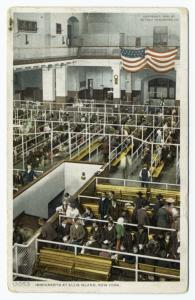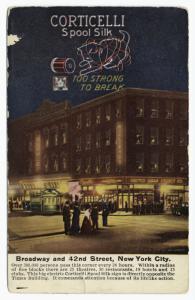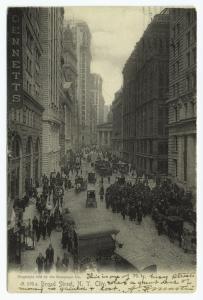The Central Libraries > Mid-Manhattan
Library > Historical Postcards
A Record of Time
 Immigrants at Ellis Island, New York
Immigrants at Ellis Island, New York
Digital ID 836573The dawning of the 20th century, coinciding with
the peak of the industrial age, saw the foundation
poured for many characteristics of New York living
known worldwide. The digitized postcards are filled
with New York flavor:
The City is home to a diverse population, representing
every language and nationality. The main Ellis
Island immigration center opened on Dec. 17,
1900 and was designed to process 5,000 immigrants
a day. This postcard was published one year after
Ellis Island’s peak year—1907—when
1,004,756 immigrants passed through the facility.
Here, they can be seen patiently waiting to be
afforded entry onto Manhattan’s shores.
 Subway Station, N.Y. City.
Subway Station, N.Y. City.
Digital ID 836135
The City is renowned for public transportation. When the first subway opened on October 27, 1904, 150,000 people paid a nickel each to ride. This postcard, which uses applied glitter to highlight the shiny metal of the rails and beams, was postmarked two years after that opening. The writer of the card expresses a lament often heard from New York commuters: "Dear Mame: Sorry I canít stop but stay'd too long here. Grace." Also digitized are many examples of street railroads and elevated railroads.
 Broadway and 42nd Street, New York City
Broadway and 42nd Street, New York City
(The big Corticelli Spool Silk sign)
Digital ID 836263New York is the town for showmanship and advertising. The postcard to the right, advertising Corticelli Spool Silk, also depicts some of the first exuberant animated electric signage to play in Times Square. The sign is described on the postcard as 45 feet wide by 50 feet high; the kitten as 36 feet wide by 30 feet high; and the lighting achieved by the use of 1,962 electric lamps.
The financial heart of the United States pulses
through lower Manhattan. The final quarter of the
19th century was characterized by the rise of big
business and industry. The empire builders J.P.
Morgan, John D. Rockefeller and Andrew Carnegie
used the concentration of capital on Wall Street
to finance their strategies of consolidating production,
monopolizing markets and influencing government,
thereby winning possession of most of the wealth
of the nation. Below is a 1905 view of Broad Street
from Wall Street, where the New York Stock Exchange
sits. A correspondent named Martin was inspired
to write, "This is one of N.Y. busy streets where
a great deal of money is gained and lost."

Broad Street, N. Y. City
Digital ID 836737